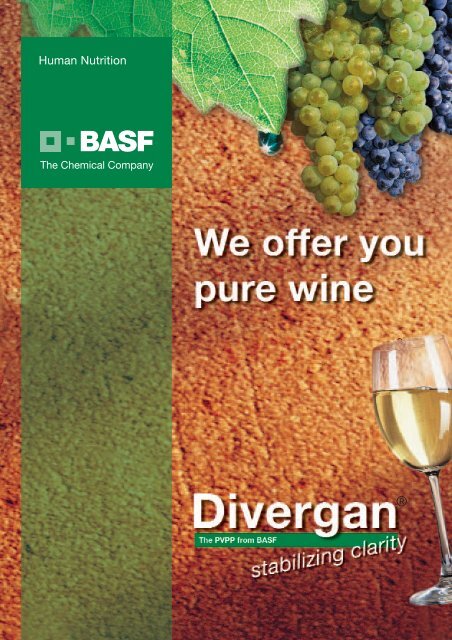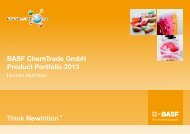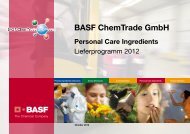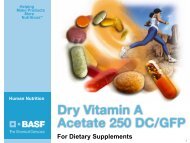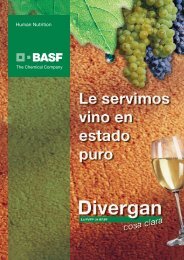Human Nutrition - BASF ChemTrade
Human Nutrition - BASF ChemTrade
Human Nutrition - BASF ChemTrade
Create successful ePaper yourself
Turn your PDF publications into a flip-book with our unique Google optimized e-Paper software.
<strong>Human</strong> <strong>Nutrition</strong><br />
®
In vino veritas.
In wine lies the truth.<br />
No discoloration.<br />
The first step in wine judging is the critical look,<br />
because the eye participates in the wine experience.<br />
It is no coincidence that the color and<br />
transparency of wine are often compared to<br />
rubies or gold. Connoisseurs prefer pure, clear<br />
wines of high quality. Enjoyment, especially of<br />
white wines, is diminished by brown or pink discoloration.<br />
The bitter tastes and discoloration<br />
occurring during the process of vinification are<br />
caused in part by so-called polyphenols.<br />
The consumer does not like<br />
impure wine. Neither do we.<br />
Divergan ® is an interlinked insoluble polyvinyl pryrolidine<br />
(PVPP). For more than ten years it has<br />
been a recognized enological procedure for the<br />
treatment of wine and sparkling wine. Both <strong>BASF</strong><br />
Divergan ® products are manufactured according<br />
to a special polymerization procedure. The ensuing<br />
dense molecular structure makes PVPP<br />
insoluble in water and all standard solvents. A<br />
clear thing for the wine.<br />
Divergan ® comes and goes.<br />
But not on its own.<br />
How does that work? PVPP is extremely choosy<br />
about relationships with other materials. Its only<br />
friends are our enemies, the polyphenols, which<br />
it loves to adsorb. Together they form sediment<br />
and then remain conspicuously absent.<br />
2/3
Don’t fish in troubled waters.<br />
Just fish the troubles out.<br />
Wine fascinates us with its lively variations of<br />
color and the play of light striking it. But sometimes<br />
a shadow falls across, which also can be<br />
caused by phenolic compounds.<br />
They are set free through the immense pressure<br />
employed in the peeling, pitting and stemming<br />
process.<br />
In part the enological processes themselves, for<br />
example prolonged fermenting of the must, also<br />
release more polyphenols into the juice.<br />
Poor color and bitter tastes in<br />
wine can have many causes:<br />
• Intense maceration of the must during the<br />
runoff process if the screw-conveyor and<br />
the pump of pumping systems are not well<br />
coordinated<br />
• Too short (smaller than 90 mm) or too long<br />
must lines, too many bends or valves<br />
• The must is allowed to stand too long<br />
• The pressing process is not suited to the<br />
grapes, or is too intense<br />
• High rot concentration in the harvested<br />
grapes<br />
• Insufficient or lack of treatment and prefiltration<br />
of the must<br />
If the polyphenols oxidize during vinification, discoloration<br />
and bitterness can result, diminishing<br />
the optical and sensory qualities of the wine.<br />
In the extreme cases, the polyphenols react with<br />
oxygen and other components of the wine such<br />
as albumen or iron, producing instable complex<br />
compounds. This leads to over-colored or cloudy<br />
wines, or wines that age too quickly.
Let’s look at it this way:<br />
You shouldn’t<br />
see anything.<br />
Unfortunately, some natural processes see that<br />
somewhat differently. The following reactions<br />
of the polyphenols lead to discoloration in<br />
white wine:<br />
• Flavanoids and other polyphenols are converted<br />
through oxidization to unpleasant or<br />
astringent flavors.<br />
• Browning and changes in color (pinking) are<br />
caused by oxidation of leucoanthocyanides.<br />
• The reaction of tannins and albumen or iron<br />
leads to clouding.<br />
Furthermore, must from regions with vintage<br />
related middle to high botrytis contamination can<br />
be negatively affected by the resulting metabolic<br />
byproducts. This can also diminish the quality of<br />
the wines.<br />
Wine is a part of good taste.<br />
And good taste is a part of wine.<br />
In the past few years the science of enology has<br />
developed an entire series of concepts for the<br />
elimination of these wine flaws. Unfortunately<br />
they can also change the character of the wine,<br />
sometimes quite drastically.<br />
For example, oxidation of the must can result in<br />
flat, less aromatic wines. The entire vinification<br />
process, as well as the separate prolongation of<br />
the initial process, can produce lean or thin<br />
wines when the grapes are not fully ripe.<br />
And what about polyphenols?<br />
Purification is necessary!<br />
There is a clear and simple answer for the<br />
problem of discoloration. Direct reduction of<br />
polyphenols in wine and must leaves the character<br />
of the wine intact, preserving its integrity.<br />
Only a small amount of Divergan ® adsorbs polyphenols<br />
in white and rosé wines as well as base<br />
wines for sparkling wines, and does so without<br />
harming their sensory potential.<br />
The treatment of red wine is also possible,<br />
allowing the character and bouquet of the<br />
wine to develop without disturbing the color.<br />
4/5
We take something out, so that<br />
there is more<br />
for you left in.<br />
Curative or preventative – how<br />
Divergan ® works.<br />
The Divergan ® products can be added to the wine<br />
that is being treated, either directly in powder<br />
form or as a suspension. For the latter, a 10%<br />
suspension of Divergan ® F is dissolved in a corresponding<br />
amount of the wine to be treated or<br />
in water. After 30 minutes developing time during<br />
which it is stirred often, the PVPP suspension is<br />
poured into the treatment vat and mixed thoroughly<br />
into the contents of the vat.<br />
Normal dosage<br />
For preventative measures in white must or white<br />
wine use a Divergan ® concentration between<br />
10g/hl and 30 g/hl. The amount of Divergan ®<br />
needed is established, for example, by browning<br />
tests. For treatment against bitterness use<br />
Divergan ® F in proportions of 15-25 g/hl.<br />
Dosage for wine damaged by oxidization is<br />
30-50 g/hl. In extreme cases, a higher concentration<br />
may be necessary. For the most effective<br />
treatment, must should be clarified and wine<br />
finely filtered. Contact times from 20 to 60 minutes<br />
are sufficient with sufficient mixing, whereby<br />
longer contact times are also possible without a<br />
negative effect on the wine. With shorter contact<br />
times, as may be used with Divergan ® F, the<br />
polymer should be added as a suspension after<br />
being allowed to develop.<br />
To save time, the wine can be filtered before the<br />
sedimentation of the PVPP is complete. The<br />
contact time, however, can also be lengthened<br />
until the refiner, for example Divergan ® F, has<br />
settled completely.
When to use refiners during the winemaking process<br />
15—30 %<br />
marc<br />
5—10 %<br />
most lees or<br />
3—5 % floates<br />
lees<br />
2—5 %<br />
yeast lees<br />
fine lees,<br />
wine scale,<br />
bases for<br />
sparkling wine<br />
(Modified according<br />
to Binder)<br />
harvest<br />
pressing<br />
must refining<br />
pre-filtration<br />
or<br />
flotation<br />
controlled fermentation<br />
1st cutting<br />
treatment and<br />
improvement measures<br />
taste<br />
refining<br />
fining and<br />
filtering<br />
bottling<br />
Bentonit, Gelatin,<br />
Divergan ¤ (PVPP),<br />
activated carbon<br />
sedimentation<br />
8—24 hours<br />
gelatine, gas<br />
or air<br />
nutrients, fermentation<br />
aids, refrigeration<br />
Bentonit, albumen,<br />
Divergan ¤ (PVPP),<br />
enzymes,<br />
activated carbon<br />
treated with<br />
Divergan ¤ (PVPP)<br />
Perlite, micro silicia,<br />
filter plates<br />
6/7
Fine Chemicals<br />
With vitamins, carotenoids, enzymes, and other products<br />
like caffeine or the amino acid lysine, we are the leading producer<br />
of additives for both the food and feed industries. We<br />
provide a valuable contribution to healthy nutrition and<br />
ecologically efficient livestock production. Active<br />
ingredients, a complete UV filter assortment, aroma chemicals<br />
and functional polymers make us partners for the<br />
pharmaceutical, cosmetic, perfumery and aroma industries.<br />
A reliable alliance with our customers is based on innovative<br />
products, consistent quality management and technologically<br />
leading production systems. We are utilizing our<br />
expertise in all important applied technologies and in the<br />
formulation of additives and active materials for the further<br />
development of our product range. Our customers can<br />
obtain a large proportion of their requirements for strategic<br />
raw materials from a single source.<br />
<strong>Human</strong> <strong>Nutrition</strong><br />
We offer our customers in the sectors food, beverages and<br />
nutritional supplements an attractive and extensive product<br />
assortment including essential nutrients, nutraceuticals and<br />
processing aids. We support our customers to satisfy the<br />
rising consumer expectations for healthy nutrition. Our highvalue<br />
products and formulations are designed for efficient<br />
processing and are distinguished by their consistently high<br />
quality.<br />
® = registered trademark <strong>BASF</strong> Aktiengesellschaft<br />
<strong>BASF</strong> Aktiengesellschaft<br />
Fine Chemicals Europe,<br />
Africa, West Asia<br />
<strong>Human</strong> <strong>Nutrition</strong><br />
67056 Ludwigshafen<br />
Germany<br />
Fine Chemicals<br />
MEEH040832e


